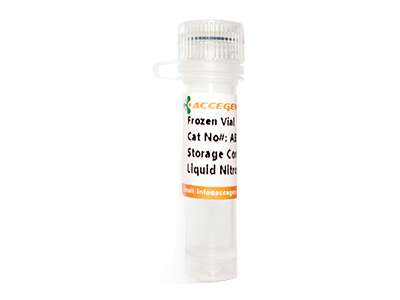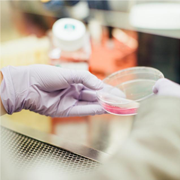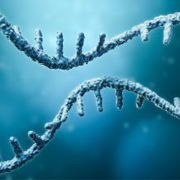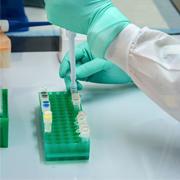Home > Products > Tumor Cell Lines > Animal Tumor Cell Lines >
LL/2(LLc1) |
||||
|---|---|---|---|---|
| Product Name |
LL/2(LLc1) |
|||
| Price | Get Quote | |||
| Product Code | LL/2 (LLc1); LL/2; LL2; LLC1; LLC; Lewis lung carcinoma line 1; Lewis lung carcinoma; Lewis Lung Cancer; Lewis-Lung; Lewis Lung |
|||
| Cat.No |
ABC-TC0591 |
Species |
Mouse |
|
| Size/Quantity |
1 vial |
Biosafety Level |
1 |
|
| Shipping Info |
Dry Ice |
Storage |
Liquid Nitrogen |
|
| Description |
The Lewis lung carcinoma line 1 (LLC1), also known as LL-2, was the lung cancer cell line derived from a primary Lewis lung carcinoma tumor in a C57BL mouse. This cell line is tumorigenic and compatible with the murine immune system. It retains its tumorigenicity in C57B1 mice,
Why choose LL-2(LLC1) from AcceGen? LL-2 cells from AcceGen undergo rigorous quality control measures to ensure sterility and exclude mycoplasma contamination using PCR and luminescence-based assays. Bacterial or fungal contaminations are detected through daily visual cell monitoring. Production involves professional operators who adhere to optimal standards, ensuring the reliability and integrity of LL-2 cells. |
|||
| Disease | Lung Cancer |
|||
| Source Organ | Lung |
|||
| Recommended Medium And Supplement | DMEM + 10% HS |
|||
| Citation Guide |
When you publish your research, please cite our product as “AcceGen Biotech Cat.# XXX-0000”. In return, we’ll give you a $100 coupon. Simply click here and submit your paper’s PubMed ID (PMID). |
|||
| Application | FOR RESEARCH USE ONLY LL-2(LLC1) cells have diverse applications in cancer research. They are useful in focus assays to evaluate drug-induced cytotoxicity, providing insights into the effects of various compounds on cancer cell viability. Additionally, LL-2(LLC1) cells are commonly employed in syngeneic animal models to assess the efficacy of anticancer treatments in vivo. These models enable researchers to study treatment effectiveness and potential side effects in a controlled environment. Furthermore, LL-2(LLC1) cells are valuable in identifying key factors in human cancer. Researchers can evaluate the impact of antibodies or inhibitors on LL-2(LLC1) cells, shedding light on potential therapeutic targets and aiding in the development of targeted cancer therapies. Overall, LL-2(LLC1) cells serve as valuable tools for investigating drug cytotoxicity, treatment efficacy, and identifying key factors in cancer biology. |
|||
| Growth Conditions | 37 ℃, 5% CO2 |
|||
| Growth Mode | Adherent and Suspension |
|||
| Product Type |
Mouse Lung Cancer Cell Lines |
|||
| Product Image |

|
|||
Frequently Asked Questions
-
What is the growth mode of LL/2(LLc1) cell line?
The LL/2(LLc1) cells exhibit heterogeneous morphology, with both epithelial-like cells and round cells present simultaneously in varying proportions. Cells are loosely attached to the culture vessel. There may be a small number of floating cells; when adherent cells are abundant, the suspension cells can be discarded.
-
what should be careful when culturing these cells?
Be careful to control the cell density to avoid it being too high, as long-term high-density culture can lead to cell stacking or clustering.
-
Is LL/2 (LLC1) cell line tumorgenic?
The LL/2 cells are highly tumorigenic and can form tumors and metastases when implanted into immunocompromised or syngenic C57BL/6 mice. However, they are weakly metastatic in mice and have been described as non-responsive to checkpoint blockade immunotherapy.
- ONLINE INQUIRY
- PRODUCT REVIEWS
Fill out a request in the form below and we’ll get back to you within 24 hours with a quote.






 generating primary tumors and lung metastases identical to the original tumor. LL-2(LLC1) cells grow as a monolayer in RPMI 1640 medium supplemented with 2% fetal calf serum, with a plating efficiency of approximately 94% and a 21-hour doubling time. Reports also indicate their stable growth in DMEM with 10% FBS.
generating primary tumors and lung metastases identical to the original tumor. LL-2(LLC1) cells grow as a monolayer in RPMI 1640 medium supplemented with 2% fetal calf serum, with a plating efficiency of approximately 94% and a 21-hour doubling time. Reports also indicate their stable growth in DMEM with 10% FBS.